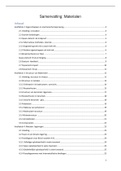Summary
Samenvatting leerstof E701029A - Materialen uit eerste bachelor opleiding tot industrieel ingenieur
Dit is een kwalitatieve samenvatting van het vak EA - Materialen. Dit vak wordt gegeven door Kim Ragaert aan de Ugent. Het behandelt alle onderwerpen van de leerstof en is verduidelijkt met afbeeldingen uit de cursus. Als je deze samenvatting goed kent, kan je het examen 100%.
[Show more]
Preview 4 out of 55 pages
Uploaded on
May 8, 2022
Number of pages
55
Written in
2021/2022
Type
Summary
Institution
Universiteit Gent (UGent)
Education
1e Bachelor Industrieel Ingenieur
Course
E701029A - Materialen (E701029A)
All documents for this subject (2)
$6.40
100% satisfaction guarantee
Immediately available after payment
Both online and in PDF
No strings attached
Samenvatting: Materialen





